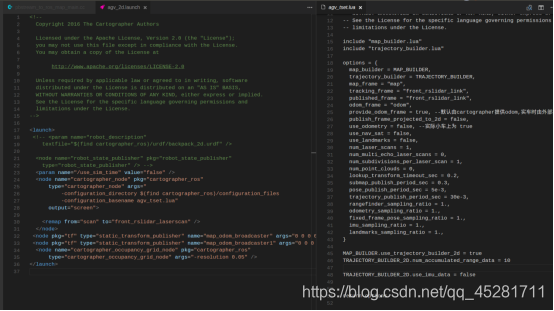Cartographer建图问题
本文共 500 字,大约阅读时间需要 1 分钟。
目前手上只有个16线的激光雷达,想在房间跑一下建图,目的是能够跑通就可以.
1,启动激光雷达, 2,将激光雷达3d点云转成2d laserscan数据类型 3,启动cartographer包roslaunch cartographer_ros agv_2d.launchCartographer配置:

终端报错:

百度谷歌了一大圈:
都说是 的问题,我把它设置成false或者注释掉都不好使.大佬可有遇到过这种情况吗?解决:
激光雷达里面设置的仿真时间,去掉之后就好<arg name="time_synchronization" default="false" /> 来cartographer launch里面这个要打开,这是显示map的节点!!!
<node name="cartographer_occupancy_grid_node" pkg="cartographer_ros" type="cartographer_occupancy_grid_node" args="-resolution 0.05" /> cartographer包中的任何文件改动后均需要重新编译运行!!!
转载地址:http://fmntz.baihongyu.com/
你可能感兴趣的文章
nessus快速安装使用指南(非常详细)零基础入门到精通,收藏这一篇就够了
查看>>
Nessus漏洞扫描教程之配置Nessus
查看>>
Nest.js 6.0.0 正式版发布,基于 TypeScript 的 Node.js 框架
查看>>
nested exception is org.apache.ibatis.builder.BuilderException: Error parsing Mapper XML.
查看>>
nestesd exception is java .lang.NoSuchMethodError:com.goolge.common.collect
查看>>
nestJS学习
查看>>
net core 环境部署的坑
查看>>
NET Framework安装失败的麻烦
查看>>
Net 应用程序如何在32位操作系统下申请超过2G的内存
查看>>
Net.Framework概述
查看>>
NET3.0+中使软件发出声音[整理篇]<转>
查看>>
net::err_aborted 错误码 404
查看>>
NetApp凭借领先的混合云数据与服务把握数字化转型机遇
查看>>
NetAssist网络调试工具使用指南 (附NetAssist工具包)
查看>>
Netbeans 8.1启动参数配置
查看>>
NetBeans IDE8.0需要JDK1.7及以上版本
查看>>
NetBeans之JSP开发环境的搭建...
查看>>
NetBeans之改变难看的JSP脚本标签的背景色...
查看>>
netbeans生成的maven工程没有web.xml文件 如何新建
查看>>
netcat的端口转发功能的实现
查看>>